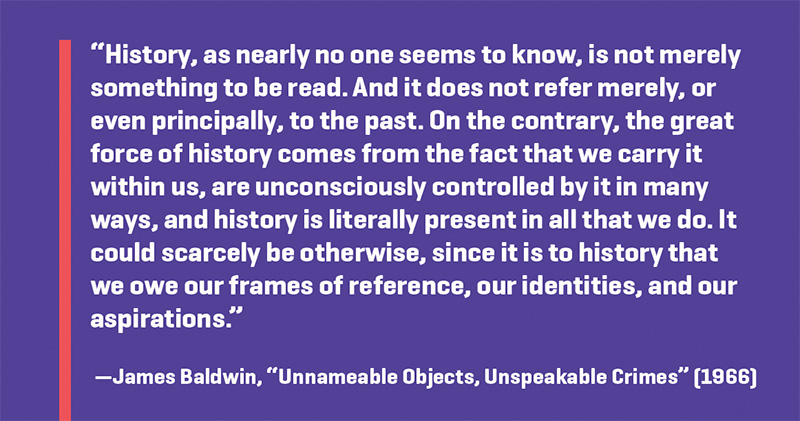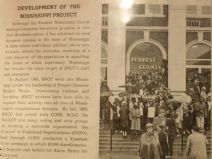As COVID-19 deaths spiked in 2020, Suzanne Firstenberg’s public art installation "In America: How could this happen…"
Black History Month
Examine collections of the Museum's key resources on major themes in American history and social studies teaching. Additional resources can be found in the main search areas of the website.
Explore Black History Month with your students using lessons, podcasts, activities, and primary sources.
Black History: Black Heritage Stamp Series
Resource Type(s): Reference Materials, Interactives & Media,
Duration: 60 Minutes
Date Posted: 10/14/2016
A topical collection featuring African-American leaders, inventors, activists, sports figures, and culture-shapers whose lives changed history. These stamps are part of the Black Heritage Stamp Series. U.S. postage stamps were in use for nearly a century before Booker T. Washington became the first African American to appear on one. A handful of additional black history-related designs appeared between 1940 and 1978, when the U.S. Postal Service introduced the Black Heritage series. USPS continues to issue a stamp featuring a notable Black American every February in conjunction with Black History Month and at other times during the year. Today the Black Heritage issues are the longest-running U.S. stamp series.
Blog Post: Art and Uprising: The George Floyd and Anti-Racist Street Art Database
Resource Type(s): Reference Materials,
Date Posted: 9/4/2020
“In March 2020, the Urban Art Mapping research team, a small group of faculty and students from the University of St. Thomas in Saint Paul, Minnesota, was busy conducting interviews with community members of Midway, a bustling, diverse neighborhood. Located in the middle of a six-mile stretch between downtown Saint Paul and downtown Minneapolis along University Avenue, Midway is a formerly white working-class neighborhood that has recently seen an influx of African and South Asian immigrants. Working in Midway for more than a year, our team had been documenting and mapping tags, buffs, stickers, murals—any sanctioned or unsanctioned art in the neighborhood’s built environment. We had recently shifted to interviewing in order to understand what community members thought about the art in their community.”
Click on the resource to continue reading.
Blog Post: COVID-19, police violence, and the historical thread that binds them: Structural racism as a public health issue
Resource Type(s): Reference Materials,
Date Posted: 9/4/2020
“Our political and legal systems are inextricably intertwined with and fueled by structural racism. This legacy predates the country’s founding, through the genocide of Indigenous populations and the kidnapping and selling of millions of Africans into slavery. Preeminent public health scholar and former president of the American Public Health Association Dr. Camara Jones defines structural racism as “a system of structuring opportunity and assigning value based on the social interpretation of how one looks (which is what we call ‘race’), that unfairly disadvantages some individuals and communities, unfairly advantages other individuals and communities, and saps the strength of the whole society through the waste of human resources." This system directly and indirectly impacts public health and the wellbeing of populations, and results in stark racial differences across various health outcomes. This underscores that deep racial health inequities are not due to the dispelled theory of biological “race,” but structural racism—the policies, practices, and norms that create and uphold racial superiority and inferiority.”
Click on the resource to continue reading.
Blog Post: Madame CJ Walker's philanthropy
Resource Type(s): Reference Materials,
Date Posted: 9/4/2020
“A former laundress who became a millionaire from her hair-care company, Madam C. J. Walker (1867–1919) was a leading philanthropist of the early 1900s. Because of her pioneering role in both business and philanthropy, she's featured in two museum exhibitions: American Enterprise and Giving in America. Her biographer, Dr. Tyrone Freeman, answered three questions from our philanthropy curator, Amanda Moniz, about Walker's giving.”
Click on the resource to continue reading.
Emancipation
Resource Type(s): Reviewed Websites, Primary Sources, Lessons & Activities,
Duration: 90 Minutes
Date Posted: 10/11/2016
This historical investigation is aligned with the C3 Framework and is from C3teachers.org.
The goal of this inquiry is to introduce students to historiography as they wrestle with historical significance within the context of a historical controversy. The common narrative about the end of slavery has given credit to President Abraham Lincoln, who earned the nickname “The Great Emancipator.” However, over the past 30 years, many scholars have sought to revise this narrative, with a critical mass now arguing that the slaves freed themselves. Students look at the laws that emancipated certain slaves over time and then examine the arguments contemporary historians have made about who was responsible for freeing the slaves. This inquiry invites students to engage with the actual historical debate, but rather than focusing on the veracity of claims, students concentrate on the significance of the issues behind the claims. By looking at the controversy about who freed the slaves, students should understand why this issue matters 150 years later. It is important to note that, in their contrasting interpretations, scholars do not really disagree on the facts of emancipation, but rather on the interpretation of those facts. This crucial difference is key to helping students engage in what it means to think and act like historians.
Greensboro Lunch Counter
Resource Type(s): Artifacts, Primary Sources,
Date Posted: 8/23/2010
On February 1, 1960, four African American college students--Ezell A. Blair, Jr. (now Jibreel Khazan), Franklin E. McCain, Joseph A. McNeil, and David L. Richmond--sat down at this "whites only" lunch counter at the Woolworth's store in Greensboro, North Carolina, and politely asked for service. Their request was refused, and when asked to leave, the students remained in their seats in protest.
For the six months that followed, hundreds of students, civil rights organizations, churches, and members of the community joined the protest and boycotted the store. Their commitment ultimately led to the desegregation of the F.W. Woolworth lunch counter on July 25, 1960. Their peaceful sit-down was a watershed event in the struggle for civil rights and helped ignite a youth-led movement to challenge racial inequality throughout the South.
Use this Investigation Sheet to guide students through describing the object and analyzing its meaning.
National Youth Summit: Freedom Summer
Resource Type(s): Interactives & Media,
Date Posted: 2/5/2014
Civil rights legend Robert Moses, Marshall Ganz, activist and professor at the Kennedy School of Government at Harvard University, students, and others participated in a panel discussion about Freedom Summer, the 1964 youth-led effort to end the political disenfranchisement and educational inequality of African Americans in the Deep South, and discuss the role of young people in shaping America’s past and future. The webcast was hosted from the Old Capitol Museum in Jackson, Mississippi. The resource includes links to lesson plans, blog post, and a conversation kit designed to spark discussion on the legacy of the civil rights movement.
National Youth Summit: Teen Resistance to Systemic Racism
Resource Type(s): Interactives & Media,
Duration: 60 Minutes
Date Posted: 9/4/2020
We will host a panel discussion connecting stories of teenagers in the past fighting to address systemic injustice to those of the present. The 2020 annual summit will be centered on the case study of Claudette Colvin—a 15-year-old Black student in Montgomery, Alabama, in 1955. Colvin refused to give up her seat on a segregated bus and testified in the legal case that brought an end to segregated busing in Montgomery. The summit will set aside time for students to discuss on the guiding question through facilitated conversation with their teachers, peers, and families. During this time, they will create recommendations for themselves, their peers, communities, and the nation about the power of teenagers to shape our present and future.
Pancaked ballet shoes worn by Misty Copeland in January 2018
Resource Type(s): Artifacts,
Date Posted: 8/12/2021
These ballet shoes were worn by dancer Misty Copeland at a January 2018 production of Black Swan, and have been pancaked (or colored) to match Copeland's skin color.
Picturing the Civil Rights Movement: Photographs by Charles Moore
Resource Type(s): Reference Materials, Primary Sources, Interactives & Media, Lessons & Activities,
Duration: 60 Minutes
Date Posted: 10/13/2016
This learner resource includes a 26 minute documentary where Charles Moore explains the context of many of his most famous civil rights images. Then, students examine the images and think about the importance of photojournalism to the civil rights movement. Finally, students are presented with Andy Warhol's image based on a Charles Moore photograph and asked to consider why certain images remain culturally significant.
Guiding questions for this collection include:
-How does seeing visual images of news events affect one differently than reading about them? Why?
-How did the photographs in this collection impact the outcome of the Civil Rights Movement?
-What makes some images more compelling than others?
-Does photojournalism have a similar impact today?
Sports and the African American Civil Rights Movement
Resource Type(s): Reference Materials, Primary Sources, Interactives & Media, Lessons & Activities,
Duration: 60 Minutes
Date Posted: 10/14/2016
Popular athletes can reflect the broader societal change that is going on around them; they can also be instigators of that change. This collection traces the African-American civil rights movement through the 20th century and touches on athletes like Jack Johnson, Jackie Robinson, and Muhammad Ali. Students can use the collection independently to learn about this subject and complete the timeline worksheet included at the end. Students will be asked to generalize about the civil rights movement during different time periods in American history, noting the shifts in focus, strategies, and success. In addition, they will draw parallels between events in sports history and the civil rights movement.
The Foundations of Freedom Summer: Close Reading
Resource Type(s): Lessons & Activities,
Date Posted: 10/25/2013
This activity is designed to encourage students to practice their critical reading and historical comprehension skills by reading about the primary source document entitled the “Development of Freedom Summer.” Key questions are posed after the reading to gauge students’ understanding of the text. This is designed as a pre-session activity for the National Youth Summit on Freedom Summer.
The March on Washington
Resource Type(s): Reference Materials, Primary Sources, Interactives & Media, Lessons & Activities,
Duration: 60 Minutes
Date Posted: 10/14/2016
The Civil Rights Movement of the 1950s and 1960s tackled many problems facing African-Americans at the time. This collection offers a brief video introduction into the March on Washington in 1963, which brought national attention to many of these issues, and asks students to analyze a photograph and three artifacts from the March. Students will answer the question "What problems did participants in the March on Washington aim to solve?" and consider how these issues continue to have relevance in the United States today.
U.S. Civil War Colored Troops Medal
Resource Type(s): Artifacts, Primary Sources,
Date Posted: 7/31/2008
During the American Civil War, General Benjamin Butler so appreciated the heroic actions of African American soldiers under his command at the 1864 battles of Fort Harrison and Fort Gilmer that he commissioned a special medal for them. Designed by Anthony C. Paquet and realized in silver by Tiffany, the U.S. Colored Troops medal had no official status. After General Butler was relieved of his command in 1865, the 300 U.S. Colored Troops who had received the medals were forbidden to wear them on their uniforms.
WANN microphone
Resource Type(s): Artifacts, Primary Sources,
Date Posted: 11/20/2008
WANN represents a significant moment in American cultural history-the rise of black-oriented broadcasting. Although blacks constituted 10 percent of the population, black interest in broadcasting on any scale, didn't begin until 1948. That year WDIA in Memphis became the first station to go to a format with exclusively black on-air personnel. Shortly after, a handful of stations committed to black interests. WANN was one of the first half-dozen. The station went on the air in 1948, and by 1950 owner and manager Morris Blum had directed his station to the black community in Annapolis and the surrounding area.






















